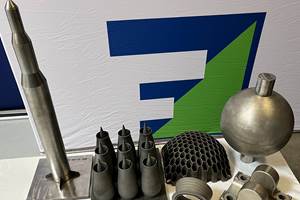Velo3D Sapphire Printers Become First Metal 3D Printers to Achieve DOD Green-Level STIG Compliance
The certification allows Sapphire printers to be connected to the DOD’s Secret Internet Protocol Router Network (SIPRNet) and gives customers confidence that their metal 3D printers are hardened against potential cyberattacks and other vulnerabilities.
Velo3D, a metal additive manufacturing (AM) technology company for mission-critical parts, has earned the U.S. Department of Defense’s (DOD) Green-level STIG (Security Technical Implementation Guide) Compliance for its Sapphire family of 3D printers. The certification allows Sapphire printers to be connected to the DOD’s Secret Internet Protocol Router Network (SIPRNet) and gives customers the confidence their metal 3D printers are hardened against potential cyberattacks.
The rigorous qualification process was achieved through collaboration with a third party to generate compliance, vulnerability and remediation reports from Sapphire printers that measure against security benchmarks. The testing process confirmed that all Velo3D printers provide the highest network, data and software security, as well as vulnerability management, reducing the risk of security breaches. This includes Sapphire, Sapphire 1MZ, Sapphire XC and Sapphire XC 1MZ. Test results indicated Velo3D achieved an average score of 97% on its tests, exceeding the DOD’s threshold of 90% needed to achieve Green-level STIG compliance, which is highest certification level offered.
The company says the team at Velo3D strives to go above and beyond to meet our customers’ needs. So when customers that work with the DOD inquired about STIG compliance, the company quickly went to work to achieve the highest level of certification available.
Obtaining the certification should empower all Velo3D customers — but especially those that work with the DOD and other government agencies — to fully leverage the capabilities of this AM technology without worrying about the risk of stolen intellectual property.
In addition to being SIPRNet-ready, Velo3D Sapphire printers can now also connect to the DOD’s Nonclassified Internet Protocol Router Network (NIPRNet). STIG compliance is required for DOD agencies and contractors that connect to both networks, as well as networks operated by other branch departments of the federal government.
Without STIG compliance, government agencies and contractors using metal 3D printers were required to keep them disconnected from network connections. This technique — commonly referred to as air gapping — can complicate the process of managing printers.
In the case of Velo3D, engineers and printer operators could not fully leverage the capabilities of its fully integrated solution, which enables users to easily monitor the printing of parts, analyze the data generated in the printing process and transfer print files to and from printers. Now, with Velo3D, engineers can utilize all aspects of metal AM technology when manufacturing parts that are classified or International Traffic in Arms Regulation (ITAR) protected without risking stolen intellectual property or other cyberattacks.
STIG compliance will also make it easier for defense contractors and agencies to purchase Sapphire printers as they will no longer have to obtain exceptions and other approvals that are required for noncompliant printers. Current Velo3D customers can easily upgrade their existing Sapphire printers to achieve STIG Green-level security. The software upgrade can be completed with minimal impact on the customer.
To learn more about Velo3D’s STIG certification and the process followed to achieve compliance, read the blog by Aaron Katske, vice president of Information Technology.
Related Content
Inspection Method to Increase Confidence in Laser Powder Bed Fusion
Researchers developed a machine learning framework for identifying flaws in 3D printed products using sensor data gathered simultaneously with production, saving time and money while maintaining comparable accuracy to traditional post-inspection. The approach, developed in partnership with aerospace and defense company RTX, utilizes a machine learning algorithm trained on CT scans to identify flaws in printed products.
Read MoreAdditive Manufacturing for Defense: Targeting Qualification
Targeting qualification in additive manufacturing for the defense industry means ensuring repeatability as well as reliability as there is much at stake, including human lives. Certain requirements therefore must be met by weapons systems used by the defense industry.
Read MoreDEDSmart Tool Harnesses Data in Real-Time for Build Quality Verification
FormAlloy Technologies’ DEDSmart technology for autonomous DED builds and build data logging utilizes enhanced in-situ monitoring and control, and the power of data, to complete builds autonomously while data logs are automatically exported enabling Digital Build Certification.
Read MoreDyndrite Joins ASTM to Provide AM Reference Data
Collaborative effort aims to create shareable reference datasets that drive consistency across the industry, accelerating qualification and adoption of metal additive manufacturing.
Read MoreRead Next
3D Printing Brings Sustainability, Accessibility to Glass Manufacturing
Australian startup Maple Glass Printing has developed a process for extruding glass into artwork, lab implements and architectural elements. Along the way, the company has also found more efficient ways of recycling this material.
Read More4 Ways the Education and Training Challenge Is Different for Additive Manufacturing
The advance of additive manufacturing means we need more professionals educated in AM technology.
Read MoreHybrid Additive Manufacturing Machine Tools Continue to Make Gains (Includes Video)
The hybrid machine tool is an idea that continues to advance. Two important developments of recent years expand the possibilities for this platform.
Read More

















